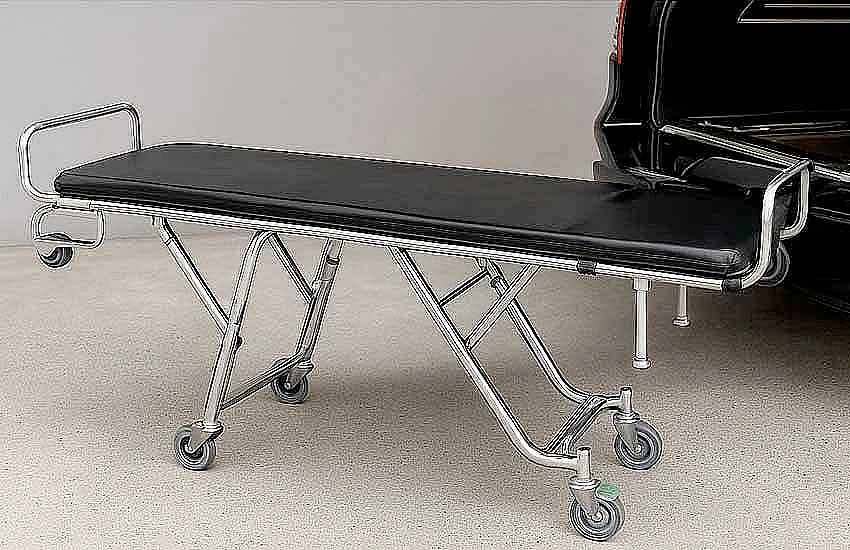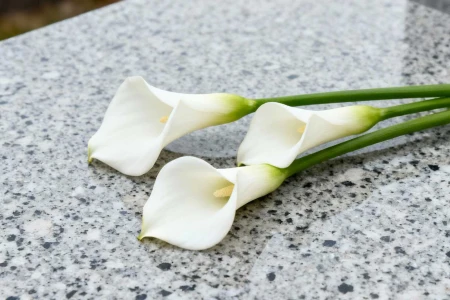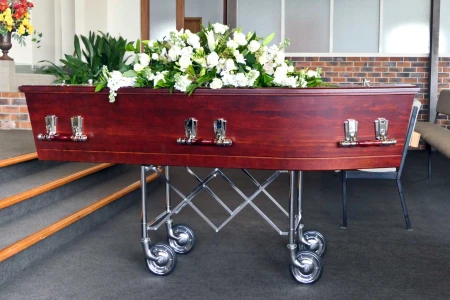Table of Contents
- Transporting the Deceased – Basic Requirements
- Comprehensive System for Transporting the Deceased
- Funeral Transport Accessories
- Ergonomics in Funeral Work
- Safety in the Transport of the Deceased
- Space Efficiency and Practicality
- Hygiene and Ease of Cleaning
- Economic Benefits of Ergonomic Funeral Equipment
- Trends in Funeral Equipment Development
- Ergonomic Mortuary Stretchers – A New Industry Standard
- 3F Ambulance Stretcher – A Revolution in Mortuary Transport
- Frequently Asked Questions (FAQ)
- Conclusion
Transporting the deceased is one of the most demanding and responsible aspects of work in funeral homes, crematoria, and municipal services. Modern standards in the funeral industry emphasize professionalism, respect for the deceased, and the comfort and safety of those performing these tasks. Ergonomic mortuary transport equipment plays a key role in this process — not only making the work easier but also enhancing the overall quality of funeral services.
Transporting the deceased is one of the most important aspects of work in the funeral industry. It requires appropriate equipment that ensures safety, comfort, and dignity. Today, funeral homes increasingly rely on ergonomic mortuary stretchers and professional accessories that facilitate daily operations while maintaining the highest standards of care for the deceased.

Transporting the Deceased – Basic Requirements
The transport of the deceased takes place in several stages—from the place of death (home, hospital, hospice) to the mortuary, chapel, and finally to the cemetery or crematorium. Each of these steps requires specific funeral accessories that ensure:
- Dignity and respect for the deceased
- Sanitary hygiene and safety
- Comfort and ergonomic working conditions for the staff
- Reliability in various weather and terrain conditions
Comprehensive System for Transporting the Deceased
Modern funeral homes must handle diverse scenarios and transport stages, each requiring dedicated equipment. A comprehensive transportation system must be holistically designed to accommodate the specifics of every phase.
- Initial transport from the place of death is often the most challenging and demands lightweight, maneuverable equipment. Folding stretchers and compact mortuary trolleys that can be operated by one person are ideal in confined spaces.
- Internal transport within the funeral home calls for specialized equipment such as scissor-type mortuary trolleys with adjustable height, facilitating movement between reception, preparation, and viewing areas.
- Ceremonial transport in churches, chapels, or farewell rooms uses aesthetic catafalques and church trolleys that combine functionality with a dignified appearance.
- Specialist transport in pathology units and hospitals involves high-end equipment like autopsy tables, trolleys with hygienic covers, and transport capsules that ensure maximum sanitary protection and discretion.
Funeral Transport Accessories
- Mortuary stretchers – essential for short-distance transfers (e.g., from a residence to a hearse or mortuary to chapel)
- Mortuary trolleys – used to transport coffins and urns within buildings and cemeteries
- Body bags – primarily used in hospitals or when hygiene is paramount
- Transport capsules – for safe movement without risk of damage
- Lifting devices and mortuary lifts – enable vertical transport, e.g., in chapels or crematoria
- Specialist vehicles (hearses, ambulances) – for long-distance transport of the deceased
The selection of appropriate equipment depends on the facility type, terrain, and operational requirements.
Ergonomics in Funeral Work
Ergonomics in the funeral industry goes beyond comfort—it’s about staff safety and respecting the deceased. Ergonomic stretchers reduce the risk of back and joint injuries among staff who regularly handle deceased persons.
Modern funeral equipment aims to eliminate factors that contribute to occupational injuries. Proper working height is a key ergonomic factor—stretchers designed to support natural body posture eliminate the need for constant bending and spinal strain. Staff can maintain correct posture, reducing back pain and related health issues.
Smooth mobility is another vital feature achieved through high-quality wheels and precision turning systems, enabling easy maneuverability in tight spaces like hospital corridors or small elevators. Staff can effortlessly control transport direction and speed.
Intuitive folding mechanisms revolutionize everyday funeral operations, allowing quick deployment without heavy lifting or complex assembly. Well-placed, anatomically designed handles ensure even weight distribution during manual handling.

Safety in the Transport of the Deceased
Safety during the transport of the deceased requires a comprehensive approach that protects both personnel and the integrity of the body being transported. Key safety aspects must be taken into account during the design and selection of funeral transport equipment.
Personnel safety begins with a stable stretcher construction that eliminates the risk of unexpected collapse or damage during transport. The aluminum frame, reinforced at critical points, ensures long-term reliability even under intensive use. This material is not only lightweight but also highly resistant to dynamic loads that may occur in challenging terrain conditions.
Anti-slip surfaces on handles and platforms are designed to prevent accidents caused by loss of control over the equipment. Special textures and materials ensure a firm grip, even in wet conditions or adverse weather. Wheel locks add another layer of safety, allowing the stretcher to be securely immobilized during critical loading and unloading procedures.
In the context of transport safety, safety belts and advanced fastening systems ensure that the body remains securely and respectfully positioned on the stretcher throughout the entire process. These solutions are designed to accommodate bodies of various sizes and to meet the specific transport demands of different environments. The damage-resistant mattress surface not only prevents fluid penetration into the stretcher's frame but also upholds the highest hygiene standards during transportation.
Load-tested construction guarantees long-term durability. Every component of the stretcher undergoes rigorous stress and endurance testing that simulates real-life conditions encountered in daily funeral home operations.
Space Efficiency and Practicality
Modern foldable stretchers represent an intelligent response to the logistical challenges faced by funeral homes operating in limited spaces. The ability to fold the stretcher into a compact form addresses the growing need for space optimization within the funeral industry.
Optimizing storage space is becoming increasingly critical amid rising rental costs and limited availability of commercial areas. Thanks to their foldability, funeral homes can store a significantly larger number of stretchers in the same area, improving the use of existing infrastructure and enhancing operational flexibility.
Transport within service vehicles gains a new level of efficiency due to the ability to place stretchers in various spatial configurations. Foldable designs allow for optimal use of cargo space, enabling the simultaneous transport of more units or combining stretcher transport with other essential funeral accessories.
Fast preparation time is a critical factor in situations requiring immediate response. Intuitive unfolding mechanisms are designed to minimize the time needed to make the equipment ready for use—especially important in urgent pickups or emergency scenarios.
Reducing logistical costs associated with transport and storage is a measurable economic benefit of modern design solutions. Smaller folded dimensions mean lower shipping costs upon purchase, easier warehouse storage, and improved operational efficiency.
Hygiene and Ease of Cleaning
Hygienic standards in the funeral industry are of fundamental importance, far exceeding typical commercial requirements. Waterproof PVC mattresses reflect an advanced approach to designing contact surfaces that must meet the highest sanitary criteria while ensuring user comfort.
An impermeable surface serves as the first line of defense against fluid infiltration into the stretcher's construction. This feature is critical not only for hygiene but also for the durability of the equipment, as it prevents the development of microorganisms and corrosion within internal structural elements. The advanced composite materials used in mattress production feature a molecular structure that blocks the penetration of all types of fluids at the microscopic level.
Resistance to disinfectants is especially important in professional high-frequency use. The materials used in modern stretcher construction do not degrade when cleaned regularly with aggressive chemical agents, preserving both their functional properties and aesthetic appearance over prolonged periods.
The smooth surface of the mattress is designed with cleaning biomechanics in mind, allowing easy removal of contaminants without the need for excessive mechanical effort. Rapid drying after cleaning is a result of the material’s carefully engineered structure, enabling immediate reuse of the equipment and thus increasing the operational efficiency of the funeral home.

Economic Benefits of Ergonomic Funeral Equipment
An economic analysis of investing in high-quality funeral equipment reveals a number of long-term financial advantages that often outweigh the initial purchase cost. A holistic approach to evaluating profitability must consider not only the purchase price, but also operating costs, maintenance, and the impact on staff productivity.
A significant reduction in service and maintenance costs stems from the use of durable constructions and high-quality materials that offer increased resistance to mechanical wear and environmental conditions. Precisely manufactured components require fewer service interventions, and their modular design simplifies and speeds up any necessary repairs.
Increased staff productivity is often an underestimated but critical economic benefit. Ergonomic solutions and the ability to operate the equipment single-handedly allow for better use of human resources, enabling more tasks to be completed with the same workforce. Reduced employee fatigue also leads to higher service quality and fewer sick days.
Minimizing the risk of equipment damage during transport directly impacts operational costs. A solid construction and well-engineered technical solutions significantly reduce the likelihood of malfunctions or breakdowns, resulting in savings on repairs and downtime.
The versatility of modern funeral equipment allows a single unit to be used in various transport scenarios, eliminating the need to invest in specialized gear for individual tasks.
Trends in Funeral Equipment Development
The funeral industry is currently undergoing rapid modernization, with equipment manufacturers introducing increasingly advanced technological solutions that are revolutionizing traditional methods of transport and handling of the deceased.
Integration of modern technologies is evident in the implementation of transport monitoring and control systems that allow tracking of parameters such as temperature, humidity, and geographical location during transport. These solutions not only enhance service quality but also provide the documentation required by increasingly strict sanitary and administrative regulations.
Eco-friendly materials are gaining importance in light of growing environmental awareness and the push for sustainable development. Manufacturers are experimenting with biocompatible composite materials that maintain all required functional properties while reducing environmental impact. This trend also meets growing customer expectations regarding corporate social responsibility.
Modular construction reflects a design philosophy that enables equipment to be adapted to the specific needs of various types of funeral homes. Modular systems allow for configuration according to individual operational requirements, which is especially important for businesses offering specialized services or operating in unconventional spatial conditions.
Ongoing automation of transport processes focuses on reducing physical strain on personnel through the introduction of support mechanisms such as hydraulic lifting systems, automatic folding mechanisms, and intelligent positioning systems. These innovations not only improve working conditions but also increase the precision and safety of transport operations.
Ergonomic Mortuary Stretchers – A New Industry Standard
One of the most important pieces of equipment in modern funeral homes is the mortuary stretcher. At funeraryaccessories.com, you’ll find a wide selection of professional stretchers that offer:
- Lightweight yet durable construction
- Foldable design for easy storage and transport
- Single-operator handling
- Waterproof materials and easy cleaning
- Safety and comfort during use

3F Ambulance Stretcher – A Revolution in Mortuary Transport
Among the most advanced solutions on the Polish market, the black 3F ambulance stretcher stands out, designed with maximum ergonomics and functionality in mind.
Key advantages of the 3F stretcher:
- Lightweight aluminum frame made of thick-walled components provides excellent durability while maintaining low weight. With a maximum load capacity of 160 kg, it is ideal for most funeral use cases.
- Foldable design is one of the stretcher’s greatest advantages. Its folded dimensions are just 190 x 55 x 25 cm, expanding to 190 x 55 x 92 cm when unfolded. This functionality enables space savings in service vehicles and funeral home storage areas.
- Waterproof mattress filled with PVC foam offers both comfort and hygienic maintenance—an essential feature in the funeral industry. The surface is fluid-resistant and easy to disinfect.
- Single-person operation is a crucial benefit that significantly facilitates the work of funeral staff. With the help of auxiliary wheels and frame-supporting legs, one person can safely transport the deceased without the need for additional assistance.
- Automatic leg folding during vehicle loading is an innovative feature that speeds up and simplifies the transport process. This system eliminates the need for manual folding, reducing the risk of equipment damage.
Frequently Asked Questions (FAQ)
Which stretcher should I choose for a funeral home?
A lightweight, foldable stretcher such as the 3F model available at funeraryaccessories.com is perfect- safe, ergonomic, and suitable for one-person operation.
Can the 3F stretcher be used by one person?
Yes. Thanks to helper wheels, support legs, and an intuitive folding system, one staff member can safely transport the deceased.
What is the maximum weight capacity of the reinforced stretcher?
The 3F model supports up to 160 kg. With additional steel reinforcements, this can increase significantly—exact figures depend on the specific model.
How easy is it to clean and disinfect the 3F stretcher?
Its waterproof PVC mattress is highly hygienic and resistant to disinfectants. The smooth, sealed surface allows for effective cleaning without damage.
What are the folded dimensions, and will it fit into a standard service vehicle?
Yes—190 x 55 x 25 cm folded. The compact size is ideal for most funeral transport vehicles and tight storage spaces.

Conclusion
Investing in ergonomic funeral equipment enhances staff safety, work comfort, and the professional quality of services. The 3F ambulance stretcher is a standout solution—combining superior design with daily usability.
Its one-person operation, space-saving design, and hygienic waterproof materials make it a perfect fit for modern funeral homes.
When selecting stretchers and funeral accessories, it’s essential to choose trusted suppliers offering high-quality products and full technical support.




